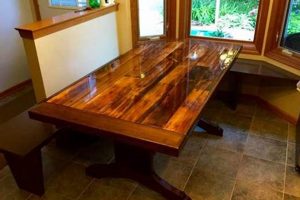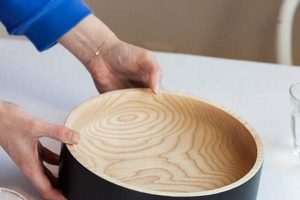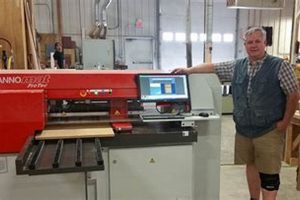The phrase “the last detail custom woodworks” represents a business specializing in handcrafted woodworking, distinguished by its focus on meticulous craftsmanship and individualized design. This encompasses the creation of bespoke furniture, cabinetry, architectural millwork, and other wood-based products tailored to specific client needs and aesthetic preferences. For instance, a project might involve crafting a unique dining table, designing custom kitchen cabinets, or producing intricate molding for a historic home renovation.
The value of such an enterprise lies in its ability to provide unique, high-quality items that cannot be obtained from mass-produced furniture or standard building supply companies. Historically, custom woodworking has been a hallmark of skilled artisans, reflecting a tradition of artistry and attention to detail. The benefits include durability, personalized aesthetics, and often, increased property value. These creations serve as enduring expressions of individual style and contribute to the overall character of a space.
The following sections will delve into the specific services offered by establishments of this nature, explore the types of wood and finishes commonly utilized, and examine the factors that influence project costs and timelines. This will provide a comprehensive understanding of the capabilities and considerations associated with commissioning custom woodworking projects.
Essential Considerations for Custom Woodworking Projects
Engaging in a custom woodworking project necessitates careful planning and informed decision-making. The following insights are designed to guide individuals through the process, ensuring a satisfactory outcome that aligns with expectations and budgetary constraints.
Tip 1: Define Project Scope Precisely: Prior to contacting a woodworking professional, articulate the desired outcome with clarity. Detailed sketches, specifications, and photographic examples will facilitate effective communication and minimize potential misunderstandings regarding design, dimensions, and functionality.
Tip 2: Prioritize Wood Selection Based on Function and Aesthetics: Different wood species possess varying characteristics in terms of durability, grain pattern, and finishing properties. Select wood types appropriate for the intended use and desired appearance. For instance, hardwoods such as oak or maple are suitable for high-traffic areas, while softer woods like pine may be appropriate for decorative elements.
Tip 3: Consider Finish Durability and Maintenance Requirements: The finish applied to wood surfaces significantly impacts their longevity and ease of maintenance. Options range from penetrating oils to protective varnishes and lacquers. Evaluate the anticipated wear and tear and choose a finish that offers adequate protection and conforms to personal maintenance preferences.
Tip 4: Establish a Realistic Budget and Timeline: Custom woodworking projects inherently involve labor-intensive processes. Obtain detailed quotes from multiple providers and factor in potential contingencies. A comprehensive understanding of associated costs and project timelines will prevent unwelcome surprises and ensure financial stability.
Tip 5: Evaluate the Woodworker’s Portfolio and References: Prior to committing to a particular woodworker, review their past projects and seek testimonials from previous clients. This due diligence provides insight into their skill level, attention to detail, and commitment to customer satisfaction. Verifying professional credentials and insurance coverage is also advisable.
Tip 6: Understand the Importance of Environmental Factors: Wood is a natural material that expands and contracts with changes in humidity. This can lead to cracks and warping if not properly accounted for during the design and construction process. Skilled woodworkers will use techniques to mitigate these effects, such as allowing the wood to acclimate to the environment and using joinery methods that allow for movement.
Adherence to these recommendations will facilitate a smoother and more successful experience, resulting in a custom woodworking product that meets specified requirements and stands the test of time.
The subsequent discussions will address considerations for design and material selection, further contributing to the successful realization of custom woodworking objectives.
1. Precision
Precision is a fundamental, non-negotiable aspect of quality custom woodworking. Its presence, or lack thereof, directly determines the structural integrity, functionality, and visual appeal of any handcrafted piece. Within a firm specializing in bespoke woodwork, meticulous accuracy is not merely a desirable trait; it is an operational necessity. Without exact measurements and skillful execution, joints may fail, drawers may bind, and overall aesthetics will be compromised. The cause-and-effect relationship is demonstrably linear: imprecise work results in substandard results, while precise execution yields superior outcomes.
Consider the construction of a complex piece of furniture, such as a reproduction of an antique secretary desk. The project requires hundreds of individual components, each demanding precise dimensions and angles. An error of even a fraction of an inch in a critical area, such as the dovetail joints of a drawer, can render the entire drawer non-functional, thereby impacting the utility of the whole desk. Furthermore, inlays, carvings, and other decorative details, also require a steady hand and an exact eye, because any deviation from the intended design detracts from the piece’s aesthetic value.
In conclusion, precision forms the bedrock upon which the integrity of custom woodworking rests. While design and material selection contribute to the overall character of a project, it is the unwavering commitment to accuracy that ultimately determines its success and longevity. The challenges of achieving precision underscore the value of experienced craftspeople, and a practical understanding of precision emphasizes its integral role in the creation of durable and aesthetically pleasing woodworking projects.
2. Materials
The success of woodworking hinges fundamentally on the careful selection and proper application of materials. For entities identifying with superior bespoke products, the choice extends beyond mere cost consideration; it necessitates a thorough evaluation of inherent properties, aesthetic qualities, and intended application. Material selection dictates the durability, stability, and overall visual character of the final product. Example: The selection of kiln-dried hardwood is vital for crafting furniture intended for climate-controlled environments. A choice of air-dried wood, without proper treatment, could cause warping and cracking over time.
The relationship between material choice and final product efficacy is linear. Utilizing a lower-grade softwood in a load-bearing structural element would invariably compromise its integrity. Conversely, using expensive exotic hardwoods may be deemed unjustifiable for purely functional, utilitarian pieces. A thoughtful woodworker thoroughly considers these considerations, to suggest the most appropriate material choices relative to the project’s needs.
The ultimate strength of custom woodworking relies on both skill and the quality of materials. A commitment to quality in material selection, paired with expert craftsmanship, defines the lasting value of custom woodworking. Material consideration serves as the bedrock upon which all other stages of custom woodworking rest.
3. Design
Design, in the context of custom woodworking, is the foundational blueprint that dictates form, function, and aesthetic value. For businesses focused on detail and customization, design is not merely a preliminary step; it is an iterative process that informs every phase of production. A direct correlation exists between thoughtful design and the ultimate success of the woodworking project. A well-considered design mitigates potential structural weaknesses, optimizes material usage, and ensures that the final product aligns seamlessly with the client’s specific requirements and expectations. For example, designing a custom bookcase requires consideration of shelf load capacity, accessibility, and the overall aesthetic integration with the surrounding environment.
The design phase incorporates several critical elements, including detailed drawings, material specifications, and considerations for joinery and finishing techniques. A failure to adequately address any of these aspects can lead to significant complications during the construction process. Consider a complex architectural millwork project. Without precise design specifications detailing dimensions, angles, and material transitions, the installation process can become exceedingly difficult, resulting in delays, increased costs, and a compromised final result. Furthermore, design decisions regarding ergonomic factors, such as counter heights or seating angles, directly impact the usability and comfort of the finished product.
In conclusion, design serves as the linchpin connecting client vision with tangible reality in custom woodworking. Challenges in the design phase, such as balancing aesthetic desires with structural limitations, necessitate a collaborative approach and a deep understanding of woodworking principles. The ultimate success of any custom woodworking endeavor is directly contingent upon the thoroughness and precision of its initial design, underscoring the importance of this phase in achieving optimal results.
4. Functionality
Functionality, within the domain of precision woodworking, pertains to the practical utility and operational effectiveness of a finished product. It represents the degree to which a piece of custom woodwork fulfills its intended purpose, considering both usability and durability. The measure of functionality is a crucial determinant in assessing the overall value and success of any project, ensuring it not only meets aesthetic criteria but also serves its practical role effectively.
- Ergonomic Design and Accessibility
Ergonomics, focusing on user comfort and efficiency, is paramount. Custom kitchens, for instance, require carefully considered counter heights, storage solutions, and appliance placement to minimize strain and optimize workflow. Accessibility features, such as pull-out shelves or adjustable-height work surfaces, further enhance usability for individuals with varying needs or physical limitations. The integration of such ergonomic design principles ensures the finished product is not only visually appealing but also facilitates ease of use for years to come.
- Structural Integrity and Load-Bearing Capacity
The ability of a custom-built structure to withstand anticipated loads and stresses is fundamental to its functionality. Shelving units, for example, must be engineered to support the weight of stored items without sagging or collapsing. Similarly, custom-built tables or benches must be structurally sound and capable of withstanding regular use and potential impact. Employing appropriate joinery techniques and material selection is crucial for ensuring long-term structural integrity and preventing premature failure.
- Space Optimization and Storage Solutions
Custom woodworking provides opportunities to maximize space utilization and create tailored storage solutions. Built-in cabinets, custom closets, and under-stair storage can effectively utilize otherwise wasted areas, enhancing organizational capacity and decluttering living spaces. The design must carefully consider the specific storage needs of the client and incorporate features such as adjustable shelving, drawer dividers, and specialized compartments for efficient organization and retrieval of items.
- Durability and Resistance to Wear and Tear
Functionality is inextricably linked to durability. A well-crafted piece of custom woodwork should withstand regular use and environmental factors without significant degradation. Selecting appropriate materials, applying durable finishes, and employing robust construction techniques are essential for ensuring longevity. Furniture intended for high-traffic areas, for example, requires more durable materials and finishes than pieces designed for purely decorative purposes. Proper maintenance and care can further extend the lifespan and maintain the functionality of custom woodworking projects.
The aforementioned facets highlight the multifaceted nature of functionality in woodworking. Addressing each of these aspects comprehensively contributes to a superior end product furniture or structures that enhance the user experience and blend seamlessly with practical applications.
5. Durability
Durability, in the context of custom woodworking, directly reflects the longevity and resilience of the finished product. For a business whose brand emphasizes attention to “the last detail,” durability becomes not just a feature, but a core promise. The commitment to enduring quality implies using materials and construction techniques that resist wear, environmental factors, and the test of time. The cause-and-effect relationship is straightforward: superior craftsmanship, characterized by meticulous detailing, results in enhanced durability. For example, a custom-built dining table, carefully constructed with seasoned hardwoods and employing robust joinery methods, will inherently possess greater durability than a mass-produced alternative utilizing less durable materials and construction.
The importance of durability extends beyond mere cost-effectiveness. Durable custom woodworking reduces the need for frequent repairs or replacements, minimizing long-term expenditure. Moreover, durable pieces often become heirloom items, possessing sentimental value and enduring through generations. Consider custom-built cabinetry in a high-use kitchen. Cabinetry constructed with durable materials and finishes will withstand daily wear and tear, resisting scratches, stains, and moisture damage. This, in turn, reduces the likelihood of costly renovations or replacements, offering a significant return on investment.
In summation, durability represents a critical component of custom woodworking enterprises that prioritize meticulous detailing. It signifies a commitment to quality, longevity, and customer satisfaction. While challenges may arise in sourcing sustainable and durable materials or employing skilled craftspeople, the resulting benefits far outweigh the difficulties. Understanding the practical significance of durability is essential for clients seeking enduring value and for businesses striving to establish a reputation for superior craftsmanship and long-term product performance.
6. Aesthetics
Aesthetics, in the realm of custom woodworking, embodies the visual appeal and artistic expression imbued within each creation. In the context of businesses focused on meticulous detail, aesthetics transcends mere surface-level ornamentation; it represents a holistic integration of form, material, and finish to achieve a harmonious and visually compelling outcome.
- Material Selection and Natural Beauty
The inherent beauty of wood species plays a pivotal role in shaping the aesthetic character of custom woodworking. The grain patterns, color variations, and textural qualities of different woods contribute significantly to the overall visual impact. For example, the rich, deep hues of walnut impart a sense of warmth and sophistication, while the light, airy tones of maple offer a more contemporary aesthetic. Thoughtful material selection is essential for aligning the visual attributes of the wood with the intended design style and the client’s personal preferences.
- Form, Proportion, and Composition
The shape and arrangement of elements within a custom woodworking piece directly influence its aesthetic appeal. Balanced proportions, harmonious lines, and well-defined forms contribute to a sense of visual order and refinement. Consider the design of a custom credenza. Achieving visual harmony requires careful consideration of the cabinet’s overall dimensions, the placement of doors and drawers, and the relationship between solid and void spaces. A well-executed design will exhibit a sense of balance and visual interest, creating a focal point within the room.
- Surface Finishes and Decorative Elements
The application of surface finishes and the incorporation of decorative elements further enhance the aesthetic impact of custom woodworking. The choice of finish, whether it be a clear coat, stain, or paint, significantly alters the wood’s appearance and texture. Decorative elements, such as carvings, inlays, or metal accents, add visual interest and complexity. The selection and application of these elements must be carefully considered to complement the overall design and avoid overwhelming the inherent beauty of the wood.
- Contextual Harmony and Integration
The aesthetic success of custom woodworking is contingent upon its harmonious integration with the surrounding environment. A well-designed piece should complement the architectural style, color palette, and overall design aesthetic of the space in which it is situated. Consider the design of custom-built bookshelves for a library. The style, finish, and proportions of the bookshelves should align with the existing architectural details and furnishings, creating a cohesive and visually unified space. A failure to consider contextual harmony can result in a jarring and disjointed aesthetic.
The integration of these aesthetic elements reflects the commitment to “the last detail custom woodworks,” demonstrating an unwavering dedication to producing pieces that exemplify both artistry and craftsmanship. Each design aspect is a testament to the precision and thoughtful execution that defines these custom projects.
Frequently Asked Questions about the last detail custom woodworks
This section addresses common inquiries regarding custom woodworking projects, providing clarity on processes, materials, and considerations relevant to commissioning bespoke pieces.
Question 1: What distinguishes custom woodworking from mass-produced furniture?
Custom woodworking offers individualized design, superior material selection, and handcrafted construction tailored to specific client requirements. Mass-produced furniture typically utilizes standardized designs, lower-quality materials, and automated manufacturing processes.
Question 2: How are project costs determined for custom woodworking projects?
Project costs are calculated based on factors including material costs, design complexity, labor hours, finishing techniques, and any specialized hardware or features. Detailed quotations are provided following an assessment of the project specifications.
Question 3: What types of wood are commonly used in custom woodworking?
Common wood species include hardwoods such as oak, maple, cherry, and walnut, as well as softwoods like pine and cedar. The selection depends on the desired aesthetic, functional requirements, and budget considerations.
Question 4: How long does a custom woodworking project typically take?
Project timelines vary depending on the scope and complexity of the design, material availability, and the woodworker’s current workload. Simple projects may take several weeks, while more intricate designs can require several months.
Question 5: What types of finishes are available for custom woodworking projects?
A wide range of finishes are available, including varnishes, lacquers, oils, stains, and paints. The choice of finish depends on the desired aesthetic, level of protection, and maintenance requirements.
Question 6: How can potential clients ensure the quality of a custom woodworking project?
Clients should review the woodworker’s portfolio, request references from previous clients, inquire about construction techniques and material sourcing, and obtain a detailed contract outlining project specifications and timelines.
Understanding these fundamental aspects of the custom woodworking process empowers clients to make informed decisions and ensures a successful collaboration with skilled craftspeople.
The subsequent segment will explore the steps involved in initiating a custom woodworking project, from initial consultation to final installation.
Conclusion
The preceding exploration has underscored the multifaceted nature of custom woodworking, emphasizing its unique blend of artistry, precision, and functionality. Examination of materials, design principles, construction techniques, and aesthetic considerations reveals the level of skill and dedication required to produce exceptional bespoke pieces. A commitment to quality craftsmanship and individualized design represents the core values of operations such as the last detail custom woodworks.
The creation of lasting, functional art remains a valued endeavor. Woodworking continues to play a crucial role in the construction of high-quality, customized environments. Businesses dedicated to precision and client satisfaction will contribute to the continuation of this time-honored craft.







